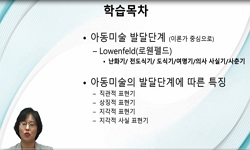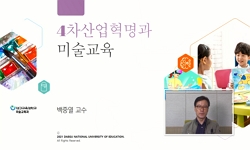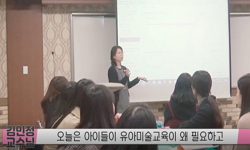본 연구는 교사, 내용, 학습자간의 구성 원리에 기초한 내러티브 기반 미술교육 프로그램을 구성하고 이를 실제 교육현장에 실행해 봄으로써 내러티브를 기반으로 한 수업 방식의 교육적 의...
http://chineseinput.net/에서 pinyin(병음)방식으로 중국어를 변환할 수 있습니다.
변환된 중국어를 복사하여 사용하시면 됩니다.
- 中文 을 입력하시려면 zhongwen을 입력하시고 space를누르시면됩니다.
- 北京 을 입력하시려면 beijing을 입력하시고 space를 누르시면 됩니다.

내러티브 기반 미술교육의 실천 = The practice of art education through Narrative-based Teaching and Learning - Centered on the study of the 3rd and 4th grade in elementary school -
한글로보기https://www.riss.kr/link?id=A102509824
- 저자
- 발행기관
- 학술지명
- 권호사항
-
발행연도
2016
-
작성언어
-
- 주제어
-
KDC
607
-
등재정보
KCI등재
-
자료형태
학술저널
-
수록면
113-140(28쪽)
- 제공처
-
0
상세조회 -
0
다운로드
부가정보
국문 초록 (Abstract)
본 연구는 교사, 내용, 학습자간의 구성 원리에 기초한 내러티브 기반 미술교육 프로그램을 구성하고 이를 실제 교육현장에 실행해 봄으로써 내러티브를 기반으로 한 수업 방식의 교육적 의의를 발견하고자 한다. 내러티브 기반 수업을 통하여 교사는 이론과 현실의 극을 줄임으로써 실천적 지식을 수행하고 자신의 경험에 기반 한 이야기를 제시하여 다소 추상적이고 비구조화 된 특성을 가지는 미술활동에 학생들로 하여금 자발적 해석의 기로를 열어주는 역할을 하게 된다. 또한 학습 내용으로써 내러티브는 그것이 하나의 소재 혹은 주제로서 활용되는 과정에서 일률적인 개념의 전달방식이 아닌 맥락 안에서 미술교육의 내용을 파악하고 소재의 의미를 효과적으로 파악하는 방식을 유도함으로써 개방적 사고를 가능케 하는 매개의 역할을 하게 된다. 학습자 내러티브는 학습의 내용을 자신의 경험과 연결 지음으로써 자연스럽게 학습상황과 자신의 삶을 새롭게 구성하고 스스로의 정체성을 확립하는데 도움을 준다. 미술교육은 다른 교육과 다르게 교사의 역량이 학습자에게 미치는 영향이 크다. 미술에서의 학습은 지식이 얼마나 많고 적음에 대한 것이 아니라 미술을 접근하는 방식에 있어 얼마나 학습자에게 친밀하게 다가 갈 수 있는 가의 문제이자 미술을 통한 자기성찰에 교육의 의의가 있기 때문이다. 본 연구는 내러티브 기반 미술교육의 연구를 통하여 교사와 학습자 모두가 미술에 대한 긍정적 사고를 확립할 수 있는 좋은 매개가 될 수 있기를 바란다.
다국어 초록 (Multilingual Abstract)
The purposes of this study are to construct an art education program based on three narrative constitution principles(teacher - content - learner) and attempts to identify the educational significance by implementing a narrative program. In this narra...
The purposes of this study are to construct an art education program based on three narrative constitution principles(teacher - content - learner) and attempts to identify the educational significance by implementing a narrative program. In this narrative program, the teacher presents practical knowledge and a story based on her own experience to decrease the gap between theory and reality through the narrative. This process paves the way for students to interpret their own content in artistic activities that are somewhat abstract and unstructured. In addition, the narrative as a content of learning leads to the way for an understanding of the content of art education and the meaning of a material within a particular context in a manner considered as a non-unified way of conveying a concept. Unlike other means of education, the learner narrative helps establish a new identity of the learning situation and the students life by linking the content of learning to their own experience. Teachers significantly influence learners in art education because learning art is not about how much knowledge acquired, but about how learners are intimately approached. Through narrative-based art education, I hope that teachers and learners can be good mediators in establishing positive thinking about art.
목차 (Table of Contents)
- 요약
- Ⅰ. 서론
- Ⅱ. 내러티브의 의미
- Ⅲ. 내러티브 기반 프로그램 구성 원리
- Ⅳ. 내러티브 기반 미술교육 프로그램과 그 실천
- 요약
- Ⅰ. 서론
- Ⅱ. 내러티브의 의미
- Ⅲ. 내러티브 기반 프로그램 구성 원리
- Ⅳ. 내러티브 기반 미술교육 프로그램과 그 실천
- Ⅴ. 결론
- 참고문헌
- Abstract
동일학술지(권/호) 다른 논문
-
- 한국미술교육학회
- 김황기(Kim Hwang Gee)
- 2016
- KCI등재
-
초등 미술교육에서 백워드 설계 현장 적용을 위한 모형 재구조화
- 한국미술교육학회
- 류재만(Ryu Jae Man)
- 2016
- KCI등재
-
- 한국미술교육학회
- 박휴용(Park Hyu Yong)
- 2016
- KCI등재
-
- 한국미술교육학회
- 양경식(Yang Kyeong Sig)
- 2016
- KCI등재





 스콜라
스콜라






